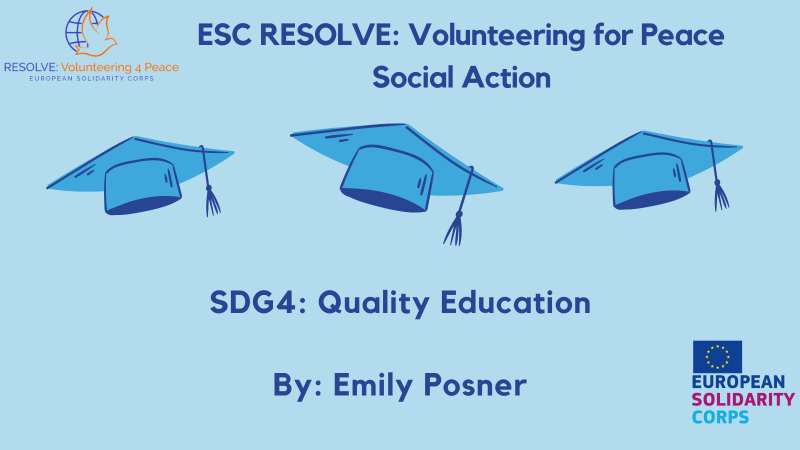The Socal action SDG4: Quality Education is a project by Emily Posner, an ESC volunteer in Brčko, Bosnia and Herzegovina, on the project RESOLVE: Volunteering for Peace, working in person with Svitac Bosnia and online with the Resolve: Network.
Over the coming months, this social action project will focus on quality education throughout the world. This will consist of a series of articles examining inequalities within specific countries, with a particular focus on those within the Balkans, the Middle East, the Caucasus, the UK, and North Africa.
Quality Education is the United Nation’s 4th sustainable development goal. They intend to “Ensure inclusive and equitable quality education and promote lifelong learning opportunities for all” due to the millions of young people worldwide who have no access to schooling or are facing overwhelming barriers forcing them to drop out or not achieve their full potential.
This topic of also of prime importance to Emily personally. For as long as she can remember she has wanted to work with vulnerable children in a tangible, meaningful way and she has spent time volunteering for GirlGuides and in a Lego therapy centre which furthered her interest in educational psychology, play therapy and social justice. After studying psychology at university and now volunteering abroad under the RESOLVE: Volunteering for Peace project, she feels she can gain experience and a better understanding for what life was like for children and their families from different backgrounds and communities and apply this to her social action project, allowing both herself and others to learn.
Article 1: “Two schools under one roof” – Understanding the impact of an educational divide for children in Bosnia and Herzegovina
Whilst the education system differs across Bosnia and Herzegovina, with some schools more integrated and others exclusively educating one ethnic group, a “two schools under one roof” approach was popularised within the primarily Bosniak and Croat populated Federation following the end of the war and the Dayton Peace Agreement in 1995. It was designed as a temporary solution to ethnic homogenisation, aiming to promote the return of refugees; yet this approach remained across 56 schools in 2020.
Check out the full article
Article 2: English as an Additional Language students in the UK
Throughout England there are approximately 1.6 million English as an Additional Language (EAL) students, accounting for over 15% of pupils. This number is growing substantially, heightening the need for inclusive educational reforms to combat the varying issues they are vulnerable to. Whilst the in-group deviation is significant, problems such as teacher labeling, insufficient resources and socio-cultural differences can limit the potential of these students. This can transpire into confidence issues and the feeling that using their mother tongue is ‘taboo’, leaving EAL pupils 20.7 months behind native speakers by the end of secondary school. Despite this, measures such as teacher training seminars appear to minimize these issues, allowing EAL students to fulfill their academic potential and have fair access to quality education.
Check out the full article
Article 3: War and the exacerbation of gender education inequalities in Syria
Globally, 250 million children are living in armed conflict. The effects of this are immeasurable and overarching, with the destruction of their homes and psychological trauma. Consequences on education are often overlooked despite them being innumerable, with 1 in 4 out of school, partially due to 1/3 of school buildings being damaged or destroyed and families fleeing. Within Syria, this is exemplified by the destruction of the only girl’s intermediary school within a community in 2016, leaving female students without any access to education. Less direct factors also exacerbate gender inequalities, leading to increases in patriarchal policies and child marriage, penalising girls’ education more so.
Check out the full article
Article 4: Armenia: An issue of disability inclusivity in education
Internationally, disability inclusivity within education is a prominent issue. Armenia exemplifies this, with children with physical disabilities or special educational needs often excluded due to social, economic, and political complexities. There is hope for change, but increased resources and awareness are vital.
Check out the full article

